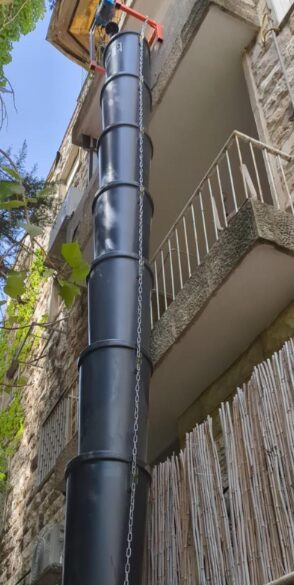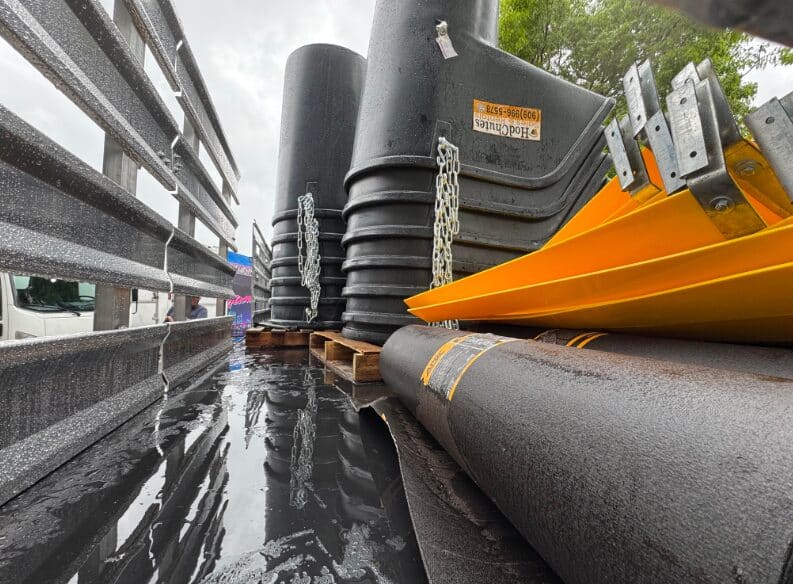When managing a construction or demolition project, one of the most critical components to ensure efficiency and safety is the debris removal system. Among available options, heavy-duty construction debris chutes stand out as an industry standard for handling bulky, abrasive, and heavy waste materials safely and swiftly.
By investing in a high-quality chute system, contractors can improve workflow, reduce hazards, and maintain compliance with construction safety regulations.
In this article, we explore what makes HodChutes heavy-duty debris chutes indispensable, key features to look for, advantages over lesser alternatives, and best practices for integration into your jobsite.
Table of Contents
The Role of Heavy-Duty Construction Debris Chutes on Job Sites
Debris chutes provide a controlled, vertical channel to transport construction waste from elevated floors to dumpsters or disposal containers at ground level. They eliminate the need for manual hauling down stairs or elevators, significantly reducing labor time and risk of injury.
Heavy-duty chutes are designed specifically to endure rigorous use with tough debris such as concrete chunks, metal scraps, bricks, and roofing materials. Lightweight or poorly constructed chutes may crack or fail prematurely under such loads, causing work interruptions and additional costs.
By choosing HodChutes heavy-duty construction debris chutes, contractors invest in durability that supports continuous job site progress and worker protection.

Key Features of Heavy-Duty Construction Debris Chutes
When selecting a heavy-duty chute system, focus on features proven to deliver strength, safety, and functionality:
1. Robust Material Construction
Typically made from high-density polyethylene (HDPE) or reinforced plastics, these chutes resist cracking, UV damage, and chemical exposure better than standard plastic alternatives. Some heavy-duty models incorporate steel or composite reinforcements for extra toughness.
2. Modular Design
Modularity allows quick assembly and length adjustment according to project height and requirements. This flexibility accommodates a variety of building types without custom fabrication.
3. Secure Mounting Hardware
Heavy-duty chutes must have rugged mounting brackets, steel chains, and clamps that secure each segment firmly to scaffoldings or balconies. Stable installation reduces swaying, protects workers below, and prevents chute detachment even under heavy load.
4. Dust and Noise Control Features
To comply with environmental standards and reduce site disturbances, many systems include covered intake hoppers and vibration dampeners. These reduce airborne dust and noise pollution from debris falling inside the chute.
5. Easy Maintenance
Smooth inner surfaces and durable construction make cleaning and inspection straightforward. This ensures long-term hygiene and safety compliance.
Advantages of Heavy-Duty Over Standard Debris Chutes
• Longevity: Extended lifespan means fewer replacements and less downtime caused by chute repairs.
• Safety: Designed to handle sharp, heavy materials safely without segment failure that can injure workers.
• Regulatory Compliance: Meets or exceeds OSHA standards for debris control and job site safety.
• Efficiency: Faster debris removal speeds project timelines by minimizing material handling.
• Environmental Control: Reduces dust and debris scattering, protecting local air quality and site cleanliness.
Comparing Heavy-Duty vs. Standard Debris Chutes
Not all debris chutes are built the same. While lightweight models offer convenience for small projects, large-scale construction or demolition work requires a more rugged solution.
Standard plastic chutes can buckle or crack when exposed to concrete, bricks, or metal scrap, especially over extended chute runs. By contrast, heavy-duty construction debris chutes are purpose-built to deal with the weight and impact of these materials.
Another key difference is hardware reliability. With lighter systems, sections may separate under load, leading to dangerous falls of loose debris. Heavy-duty systems incorporate reinforced connection hardware, steel chains, and stronger brackets to secure against sway and separation.
This difference in design translates directly into safer conditions for workers and reduced liability for contractors.
Practical Applications of Heavy-Duty Construction Debris Chutes
Heavy-duty debris chutes are versatile tools suitable for:
• High-rise construction: Moving heavy masonry debris safely from tall buildings.
• Roofing projects: Rapid removal of tiles, shingles, and underlayment over rooftops.
• Demolition work: Handling dense rubble and metal fragments reliably to reduce job site hazards.
• Commercial renovations: Clearing mixed debris efficiently without disrupting interior workspaces.
Each application benefits from the strength, scalability, and safety features that heavy-duty systems provide over basic plastic or rubber chutes.
For contractors working on demanding projects like demolition and roofing, selecting heavy-duty debris chutes specifically designed for these applications is essential. Explore our full range of heavy-duty construction debris chutes for demolition and roofing to find durable, high-quality solutions tailored to your project needs.
Cost Savings and ROI
Many contractors initially hesitate at the higher upfront cost of a heavy-duty chute system. However, looking at the lifecycle investment reveals a clear financial win. Basic chutes used on heavy projects often need to be replaced midway, doubling equipment costs. Add to that the labor delays and potential accident costs, and the cheaper option quickly becomes far more expensive.
Heavy-duty chutes, on the other hand, are engineered with longevity in mind. A single set can be reused across multiple jobs without significant wear. Contractors also reduce insurance risks when workers operate in a safer, cleaner environment. Over time, the extra investment generates measurable savings by lowering replacement frequency, avoiding project slowdowns, and showing clients a high level of professionalism.
Selecting the Right Heavy-Duty Debris Chute for Your Project
Consider Project Height
Longer chute runs require reinforced segments and secure attachments to avoid failures due to weight and wind conditions.
Evaluate Debris Type
For abrasive materials (e.g., concrete, brick), opt for chutes specifically rated for high-impact resistance.
Calculate Debris Volume
Heavy workload demands chutes with larger diameters and extra strength to handle frequent use without clogging or damage.
Weather Resistance
If your project is outdoors or long-term, choose UV-resistant, weatherproof materials and hardware that withstand heat, cold, and moisture.
Innovations in Modern Chute Systems
Today’s debris chute systems are far more advanced than those from decades ago. Contractors can choose solutions with modular design, enabling flexible chute heights for everything from two-story renovations to high-rise projects. Some models even integrate dust suppression features to keep jobs compliant with increasingly strict environmental standards.
Another area of innovation is noise control. Older chutes often rattled loudly as debris traveled down, which made them unwelcome in dense urban neighborhoods. Modern heavy-duty models are designed with vibration-dampening features and tighter connections, greatly reducing operational noise. These improvements allow projects in noise-sensitive areas to proceed with less community disruption.
Sustainability is also on the rise. Many manufacturers now produce chute sections with recycled HDPE, offering the same strength and impact resistance while reducing their environmental footprint. Contractors looking to emphasize green building practices benefit from this choice during client presentations and compliance reviews.
Installing and Maintaining Heavy-Duty Debris Chute Systems
For optimal performance:
• Use manufacturer-supplied mounting hardware and follow installation guidelines precisely.
- Conduct regular visual inspections for cracks, loose fittings, or wear signs.
- Train crew members on safe usage, load limits, and chute maintenance tasks.
- Keep spare parts and modular sections onsite for quick replacement if needed.
A well-installed and cared-for chute system reduces accidents and keeps your project on schedule.
Best Practices for Use
Even the most durable chute systems require thoughtful setup and operation. First, contractors should ensure strategic placement close to debris-heavy work areas, reducing the temptation for teams to manually haul loads down stairs or elevators. Using proper intake hoppers protects chute openings from oversize materials, ensuring smooth flow and lifespan preservation.
Regular inspections are also crucial. A quick daily check for chain wear, cracks, or shifted brackets can prevent major issues before they cause system failure. Training workers on chute safety, including correct debris sizes and maximum loading rates, further ensures reliability.
By following these simple steps, contractors can maximize both performance and safety, extending the working life of their heavy-duty chute system.
How Heavy-Duty Debris Chutes Enhance Job Site Safety
Manually carrying debris down stairs or elevators increases risks of slips, falls, and musculoskeletal injuries. Enclosing debris transport in a chute protects workers and passersby from falling objects. Additionally, dust control features limit airborne particles that could affect respiratory health.
By minimizing manual material handling and containing waste effectively, durable debris chutes contribute significantly to safer construction environments, which benefits workers and overall productivity.
Real-World Applications
Examples of heavy-duty chute use highlight just how versatile they are:
• High-Rise Demolition: Large concrete slabs and steel scraps need safe, efficient transport from upper floors.
• Roofing Projects: Shingles and underlayment slide down quickly without damaging landscaping or walkways below.
• Commercial Renovations: Heavy flooring, drywall, and fixtures can be cleared discreetly, minimizing disruption to tenants or customers.
• Bridge or Infrastructure Jobs: Chutes allow quick disposal of concrete and rebar while keeping crews on schedule.
Across these use cases, the system not only improves time efficiency but also minimizes hazards that come with manual hauling.
Invest in Heavy-Duty Construction Debris Chutes for Reliable Jobsite Waste Management
Construction professionals know that proper debris handling is paramount to site efficiency, safety, and regulatory compliance. Investing in heavy-duty construction debris chutes offers a long-lasting solution that stands up to the most demanding materials and weather conditions.
For reliable, professional-grade chute systems designed to maximize safety, durability, and ease of use, contractors trust HodChutes’ heavy-duty construction debris chutes. Their products combine robust materials, modular adaptability, and trusted installation hardware to meet the diverse needs of modern construction sites.
Equip your project with the best debris chute solutions to save time, reduce hazards, and keep your site running smoothly from groundbreaking through completion.





